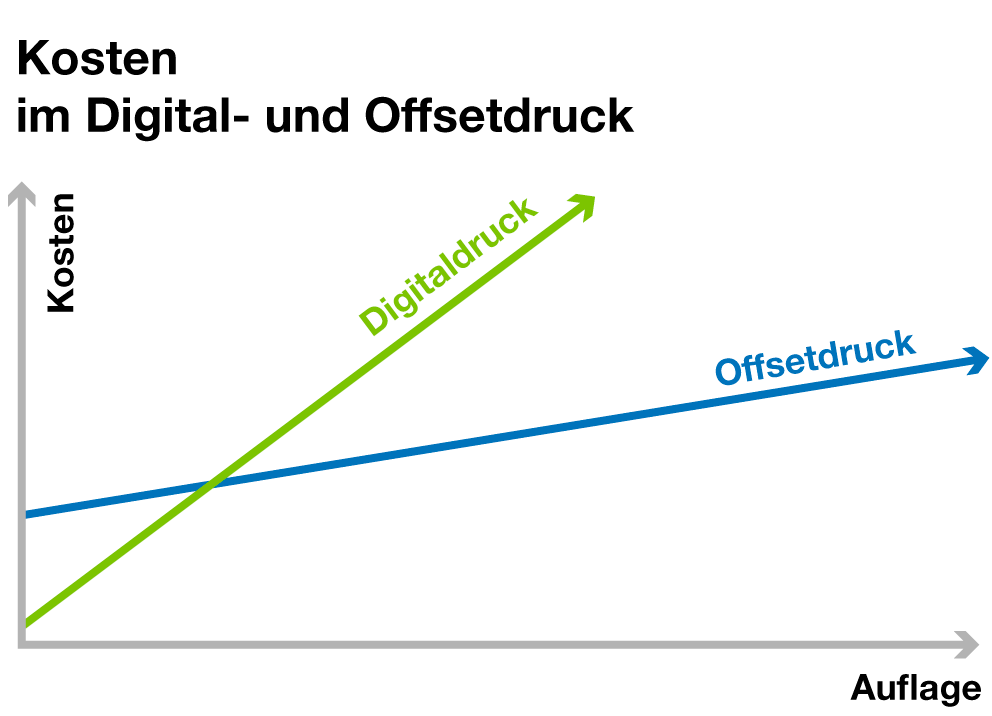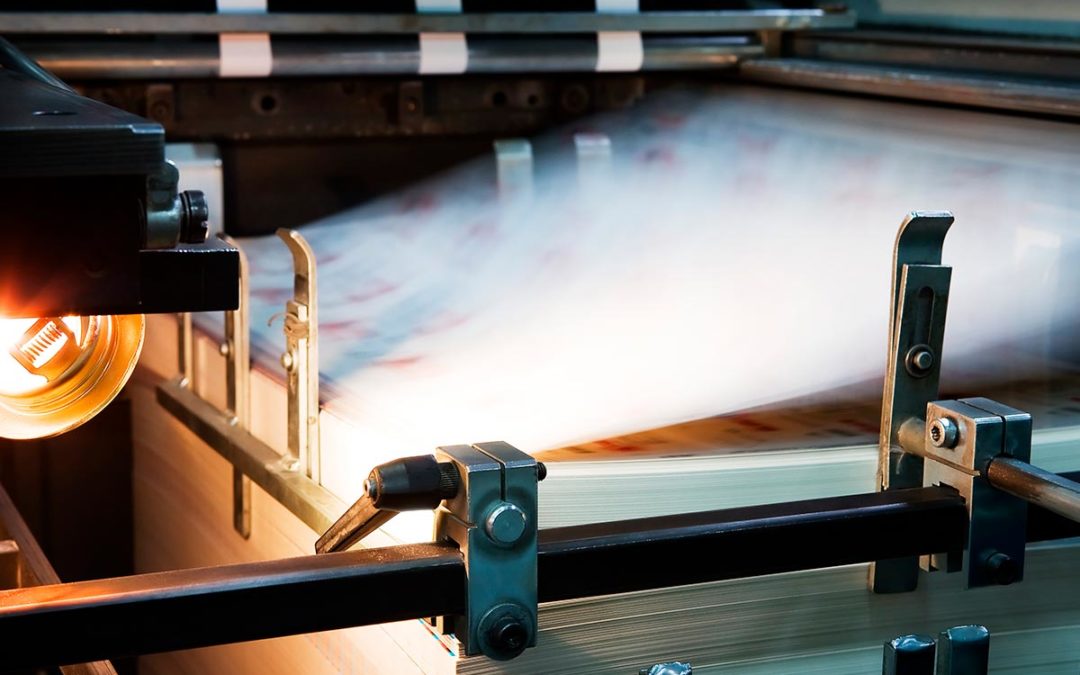Offset or digital printing – what is the best printing process for business cards? There is no one universal answer to this question. That’s why we are taking a closer look at the advantages and disadvantages – and are going to clear up some prejudices.
For those who have had little to do with printing until now, first a simplified description of the two processes:
Offset printing: The larger the print run, the more economical
In offset printing, ink is transferred from aluminium plates to a so-called printing blanket made of rubber, and from there it’s applied to the paper. The greatest effort is not the printing itself, but everything that has to happen beforehand: The exposure of the printing plate, inserting it into the printing machine, adjusting the ink application, checking the accuracy of fit (i.e. if the different colours are printed exactly on top of each other) and much more.
Even if many production steps are automated by now, they still cause high fixed costs – not ideal for the small print runs needed for business cards.
Once the offset press runs at full speed, the printing process takes no time at all: 250 sheets, for example, can be printed in a single minute on a modern press. Offset printing ink is very cheap, so the additional expense for an extra print run consists almost solely of paper, cutting and packaging costs.
This is also the reason why some printing companies offer 1000 business cards for hardly more than they do 100 or 200. (Too bad that very few people really need 1000 cards, which means that high amounts of paper are used up unnecessarily).
Digital printing – the solution for small print runs
With digital printing, the effort is more linear: no printing plates, no ink changes, hardly any make-ready work on the press.
Most digital presses operate like a giant laser printer: With each revolution, a laser beam writes the print image onto a drum. For the transfer of ink onto the paper, however, various methods are used. Recently, for example, inkjet processes have gained in importance, where ink is sprayed onto the paper from fine nozzles. A special case of digital printing is the so-called digital offset printing: Here, the ink layer – as in offset printing – is first transferred to a rubber blanket and only then to the paper.
However the process works exactly: In digital printing 1,000 different sheets can be printed just as fast as 1,000 identical ones. Or, for example, 10 x 100 identical sheets – as is the case for business cards. Nevertheless, the digital press is slower overall and the ink is more expensive, so the expense curves of offset and digital printing usually meet somewhere between 200 and 1,000 sheets.

Which process is ideal for business cards?
But now to the question that is important for business card buyers: Which process is ideal for my business cards?
Despite the differences mentioned above, the price is rarely an issue. Viewed in absolute figures, the pure printing costs for business cards are very similar in offset and digital printing – apart from a few exceptions. The design, artwork creation, process costs (on the customers’ side, as well as on the manufacturer’s side), paper, finishing and logistics are far more significant factors. Therefore, the most important question when deciding on a printing process is: Which will produce the best results?
“Offset good, digital bad” is a widespread preconception that dates back to the early days of digital printing and is now long out of date. High-end digital presses are now capable of producing a large number of print jobs in a quality that is equivalent to or even better than that of offset printing presses. Nevertheless, there still are some points that speak in favour of offset printing.
Advantages of offset printing
- Paper selection: While offset printing is possible on almost any – even very cheap – paper in good quality, many digital presses only achieve perfect results on especially optimised and often more expensive substrates.
- Print resolution: Offset prints can achieve an extremely high resolution because the printing plates are exposed at 2400 dpi or more. Even though digital presses are constantly improving in this respect as well, this can still make a difference when using very fine fonts in small sizes – as they are found on some business cards.
- Positioning accuracy: Offset presses have elaborate gripper systems and are extremely precise when guiding the paper. This means that the printed image lands in exactly the same spot from one copy to the next. This is important for later finishings e. g. embossing, or when cutting tricky designs e.g. business cards with printed frames.
- Spot Colours: An offset press can not only be filled with the basic colours of four-colour printing (cyan, magenta, yellow, black), but also almost every conceivable spot colour (e.g. metallic and fluorescent colours or PANTONE and HKS colours).
Furthermore, the biggest disadvantage of offset printing – which is relatively high make-ready costs – is kept within limits if many similar jobs are grouped together: “collect run” is the magic term here: For example, on a sheet measuring approx. 70 x 100 cm there is room for far more than 100 different types of business cards. The plate and makeready costs are thus distributed over a large number of individual jobs and are hardly of any significance. In this way, some of the advantages of offset printing can also be used for producing business cards at low cost.
However, with this collective production some of the advantages are immediately lost: the choice of paper is limited because all jobs in a collective form naturally have to be printed on the same paper and therefore collect forms only make sense for paper types that are in high demand. And spot colours are hardly ever possible with collect forms because only rarely do enough jobs come together that require exactly the same spot colours.
Digital printing also offers several advantages when it comes to business card production:
Advantages of digital printing
- Speed: Since makeready time is limited to loading the right paper and performing a few mouse clicks, the shortest of runs can be handled very quickly and with great flexibility.
- Customisability: Even a run of 1 is no problem, which can not only be useful for personalised mailings, but also for serialised cards, for example.
- Single instead of collect production: Collect forms only bring minor advantages in digital printing, therefore also individual types of business cards can be printed at similar costs. This is especially practical when using special types of paper for which a collect form is not profitable.
- High colour fidelity: The best digital presses on the market today can be controlled so precisely that they often achieve higher colour repeatability than the average offset press. This is an important factor when it comes to business cards.
- High colour intensity: Especially on uncoated papers, digital prints achieve a more intensive colour impression because the ink layer remains on the surface rather than penetrating deep into the paper fibres and thus „hiding“, as is the case with offset printing.
- Immediate further processing: Digital prints usually exit the press completely dry and can immediately be further processed – e.g. cut or folded. In offset printing this is only possible in special cases (in UV printing or with simultaneous varnishing).
- Offset like appearance: So-called digital offset presses – e.g. HP Indigo – deliver results that even on closer inspection look like conventional offset prints. The typical “photocopier shine” of some toner machines is not present here.
- Colour range: The latest digital presses can not only produce CMYK, i.e. standard four-colour printing, they also use additional colours such as orange, violet and green to simulate spot colours – and with very good success. This means that many PANTONE colours can be printed without time-consuming re-inking of the press.
Conclusion: Let experts decide
As you can see: whole books could be written about the exciting technological battle between offset and digital printing – and there currently is no clear winner. Too many factors such as paper, colours, finishing, and even the graphic design of your business cards play a role in this decision to be able to give a general recommendation for non-professionals. Even graphic designers who create a corporate design sometimes do not know the technical possibilities well enough to find the optimal method of production.
The smallest piece of paper in a company is often the most challenging to produce. That’s why especially when it comes to business cards, you should never do without professional advice: Show or send your business cards or your designs to your suppliers, let them advise you thoroughly and, if in doubt, have them produce samples for you. There almost always are several options – and you will be surprised how big the differences are.
PS: You might have already guessed it: prinux offers business cards in both offset and digital printing 🙂

